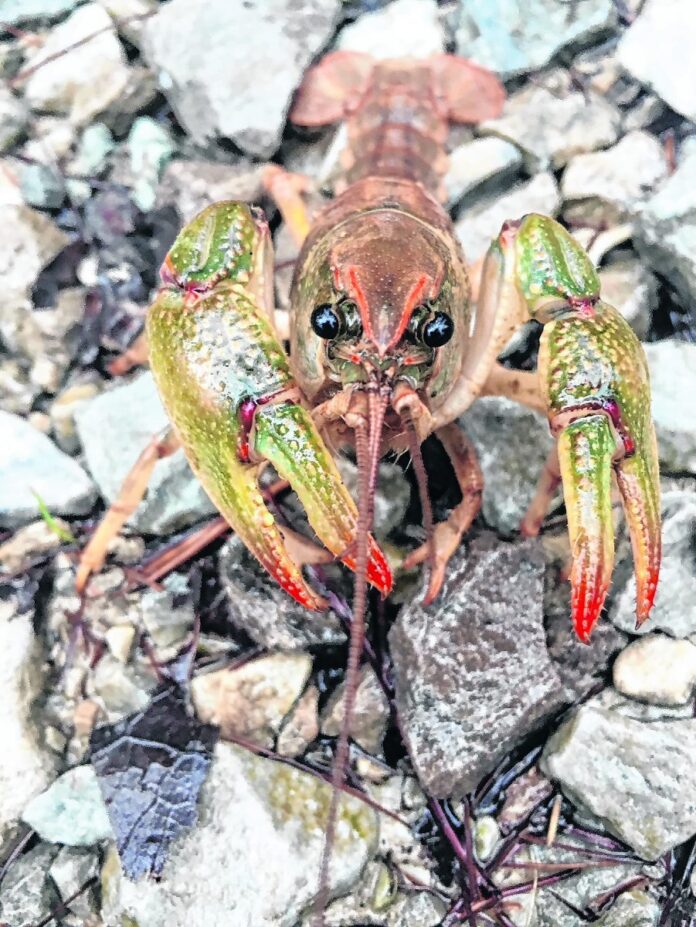
By LESLIE BISHOP, guest columnist
Since the heavy snow of February melted, the signs of spring surprise me daily.
Spring seems to tip-toe in as the weather alternates between cold and warmth.
First the sandhill cranes re-appeared, making their journey to their northern nesting grounds and filling the sky with their delightful chortles. Then the wood frogs, clucking like chickens, congregated in temporary forest ponds where they mated and left their fertilized eggs.
Next the spring peepers provided a deafening surround-sound of chirping chorus on warm nights. The first spring wildflower, the small white Salt and Pepper, appeared in early March, and I am just beginning to see the first leaves of Spring Beauty, Trillium and Toothwort.

All of these harbingers of spring are like old friends that I anticipate seeing every year. But this year I noticed something different: Crayfish emerging from their burrows after a heavy spring rain. On one evening, our front yard seemed to host a parade of large colorful crayfish. A new sign of spring.
We often see the characteristic stacked chimneys around crayfish burrows in our yard, but we rarely see the inhabitants. The crayfish species that do not live in lakes, ponds or streams excavate deep and complex burrows, often including branches and chambers.
As the crayfish excavate their burrows, they kick up balls of mud that accumulate around the burrow openings. Recent studies have found that the chimneys enhance air circulation in the burrows. One crayfish may have one to three entrances to a burrow, and usually one entrance without a chimney. These elusive crayfish spend most of their life in their burrows where they are protected from predators and desiccation.
After the first warm rains of spring, the crayfish will emerge from their burrows and aggregate in temporary pools of standing water to mate and to eat. As these spring pools dry up, the crayfish return to their burrows.
Some crayfish will mate in their burrows instead of in the pools. Females will produce a batch of eggs and attach them under their bodies with a special “cement gland.” Numerous babies hatch and cling to their mom’s abdomen for a couple of weeks until they have developed into miniature crayfish. These young crayfish will disperse and live in pools or small flowing streams. As they mature, they will return to the burrowing lifestyle. Details of their life history vary from species to species, but much is unknown.
There are around 22 species of crayfish in Indiana and of these only five species are considered “primary burrowers” like our yard crayfish. Most of what is known about crayfish biology is from research on stream and lake crayfish, primarily because they are more easily observed.

The life histories of burrowing species are less well known. But what is known is their ecological importance. Numerous other animals, such as insects, spiders, mice, frogs and snakes, take advantage of the burrows for shelter. The endangered Crayfish Frog actually requires crayfish burrows for survival, and the rare Hines Emerald Dragonfly uses the burrows in its larval stages.
Crayfish are vital components of food webs and are preyed upon by over 200 animal species including birds, reptiles and mammals. In addition, their burrowing activity mixes deep substrates with the surface, thus improving the quality of soil and upcycling nutrients, which then become more available to plants.
As I write this, the rain is coming down, but it is too cold for crayfish. I am excited for a warm, rainy day to search for emerging crayfish who add yet another interesting dimension to the onset of spring.
Leslie Bishop is a Brown County resident and retired biology professor from Earlham College. She can be reached through the newspaper at [email protected].



